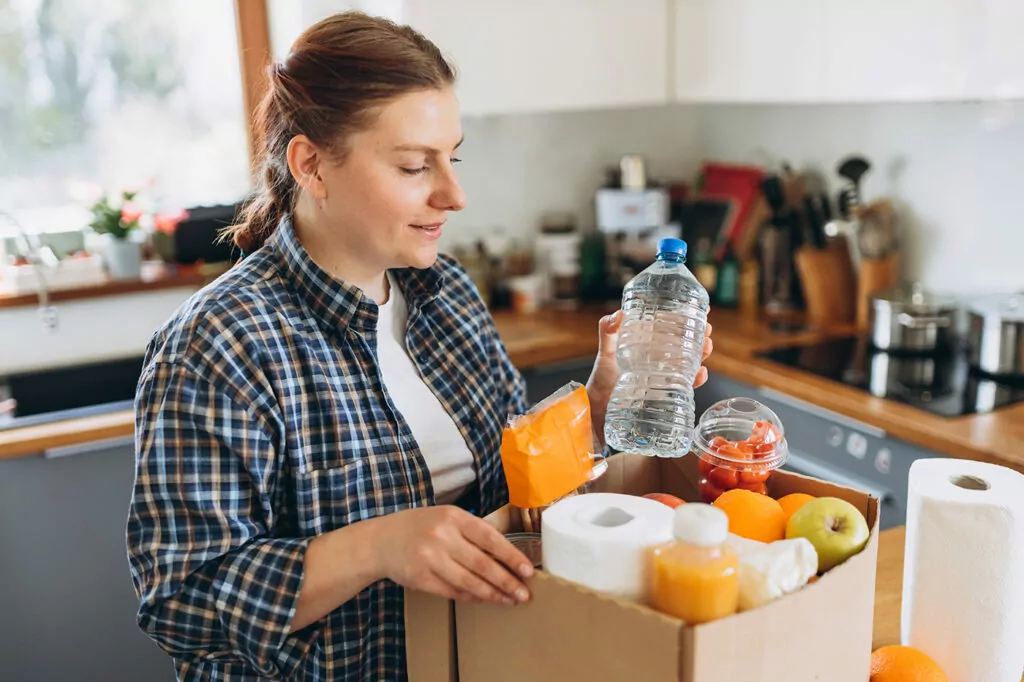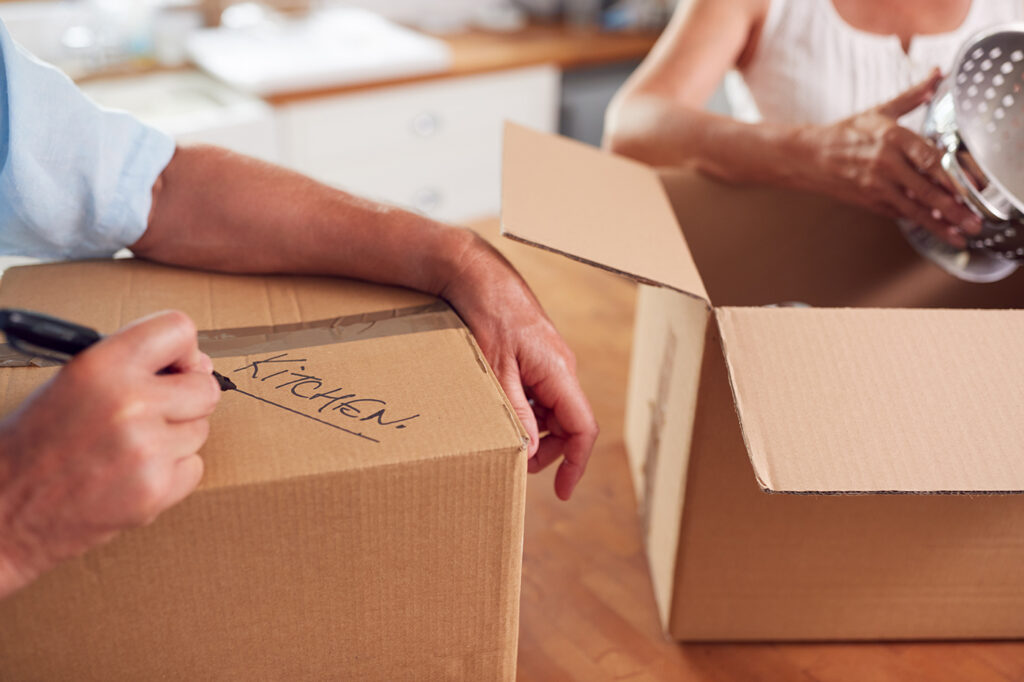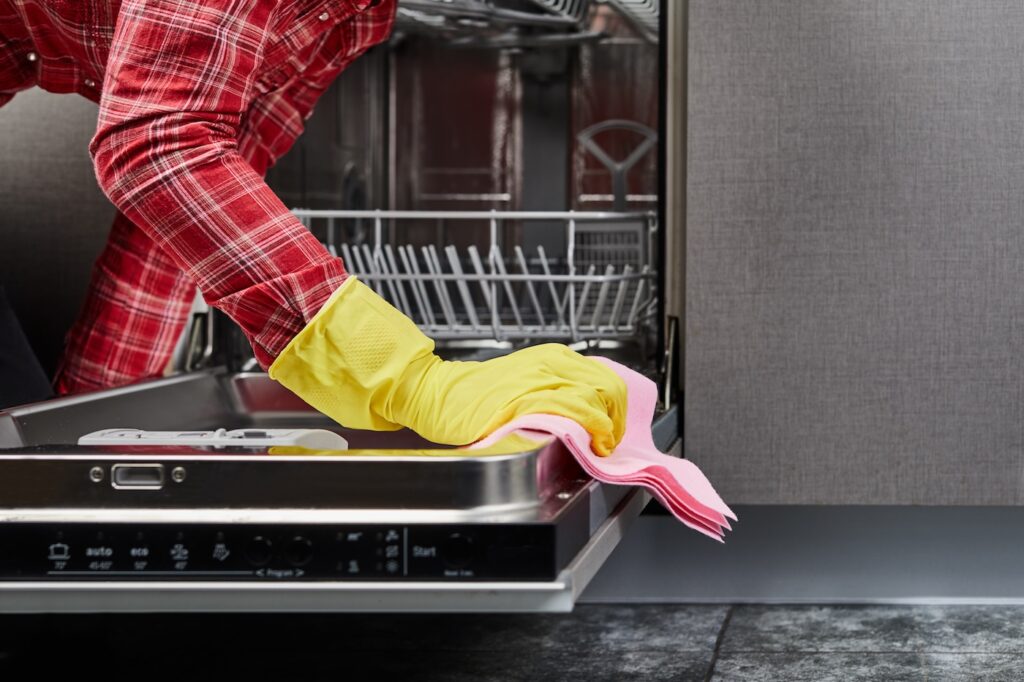Packing a kitchen is no easy task. There are lots of items to consider—from figuring out how to pack pots and pans to how to best pack kitchen appliances of all sorts, shapes, and sizes. The kitchen is also the room with the most hard-to-pack, fragile items. Knowing how to best pack kitchen items for moving takes time, patience, and a lot of moving boxes.
You may be asking yourself pre-move, ‘Which items should I pack first?’ or ‘What kind of packing material do I use to keep these glasses and dishes from breaking?’ Luckily, the answers to these questions and more are right inside this guide to packing kitchen items for moving. This post will guide you through the packing hacks and tips that will save you the trouble of broken dishes or using expensive packers. Plus, you’ll get a list of supplies needed for the process that will leave you with the confidence needed to expertly pack those boxes.
How to Pack Kitchen for Moving in 3 Steps
1. Collect the Packing Supplies Needed

Here’s a list of several packing supplies you can use to pack your kitchen.
- Moving boxes for appliances, dishes, silverware, loose and fragile items.
- Bubble wrap or packing foam to protect fragile items from clinking together.
- Plastic wrap to separate glass containers and provide padding.
- Plastic bags to contain loose items.
- Box dividers to transport glassware safely.
- Packing paper to prevent pots and pans from scraping.
- Towels to provide extra padding between items.
- Packing tape to securely seal moving boxes.
- Markers to label moving boxes and simplify the unpacking process.
2. Select the Essentials

Pack the essentials before the moving company arrives. You’ll want to make sure those items are taken care of so they don’t get mixed up with other boxes (or worse yet, become lost!) during the packing process. Your essentials box may include food items, condiments, utensils, glassware, mixing bowls, your beloved coffee machine, and dishware.
3. Item Wrapping

Here’s an easy-to-follow guide on how to wrap and pack several types of kitchen items so you can prevent damage during the moving process, especially if you’re moving long distance. Read on to learn about the different ways to declutter your kitchen and securely wrap everything from pots and pans to kitchenware.
Pots and Pans

Thankfully, pots and pans aren’t as fragile as other kitchen items when it comes to kitchen packing. However, they still need protection from dents, scrapes, and the risk of broken handles in a bumpy moving truck. Stack smaller pots and pans into larger ones to save space in your moving boxes. Use towels or packing paper to stuff around the pans in the moving boxes to provide extra padding and prevent scraping. Remove any glass lids from pots and pans and stack these like you could glass plates, wrapping bubble wrap, foam, or packing paper around each lid. Seal the box with packing tape and write down what’s inside the box with your markers.
Plates and Bowls

Stack flat plates and nest bowls into each other to make them easier to pack. Use medium-sized moving boxes so you don’t overfill them. Avoid overpacking as dishes like plates and bowls that can become heavy, making the moving boxes prone to falling apart (or worse yet, you accidentally break a plate!). Use bubble wrap for extra cushion around your plates and bowls so they don’t clink together during the moving process. Seal the medium-sized box with packing tape and label it accordingly with your markers.
Glasses and Cups

Prevent damage to your breakable glassware by packing them with the right packaging materials. Pack your fragile items like stemware and glass cups vertically and all in one box with dividers. Wrap glasses with at least two layers of packing paper. Stack them on top of each other with the packing paper and dividers in between. Add bubble wrap for extra cushions and seal it with packing tape. Clearly label the boxes using your markers.
Knives

Carefully pack knives to avoid sliced boxes, damaged blades, or accidental injury. Take a large sheet of packing paper or foam and fold it over a knife. Lay another knife facing the opposite direction over the fold. Repeat until all your knives are separated by the packing paper or foam. Then secure it with rubber bands or packing tape, wrap it all up with bubble wrap, and label the heavy-duty boxes with your markers.
Utensils

Remove your utensils from the tray organizer and go through each type, stacking forks, spoons, flatware, and knives together neatly. Pick up and wrap the stacks of cutlery tightly in plastic or a sheet of packing paper. Then, secure it with a rubber band and place it back into each section in the tray organizer. Note: If you don’t have a tray organizer for your utensils, place the stacks in a sealed plastic bag inside a medium-sized box.
Small Appliances

Smaller kitchen gadgets that you use for food preparation can be packed as well. Small appliances like mixers, toasters, and coffee makers are best packed in their original boxes. But if you don’t have the original boxes, you can wrap the appliances in dish towels or packing paper before placing them in moving boxes. Dividers, and even cookbooks, can also help prevent appliances from shifting around in the packed boxes. You should pack only one appliance per moving box so it won’t be too full or heavy, potentially injuring your back.
How to Pack Kitchen Items FAQs
Is it possible to pack appliances without boxes?
Yes, it is. For large appliances and heavier items, you don’t need to use moving boxes. To protect your appliances from damage such as dents or scratches when moving, wrap the appliance in plastic or moving blankets. Secure any disconnected cords to the appliances with moving tape.
How many boxes do I need to pack a kitchen?
You’ll need several boxes of different sizes to properly pack a kitchen. A safe bet for an average kitchen would be to get started with five small boxes, 10 medium-sized boxes, and five large boxes. Consider having three extra large boxes on hand for extra appliances, cookware, or kitchen supplies you need to pack.
Need packing help?
Should you need an extra set of hands in addition to these packing tips, know that Taskers are always available to help pack. Reliable Taskers can pack—and even unpack—your kitchen cupboards and moving boxes so you can quickly settle into your new home and enjoy your kitchen. Enjoy a smooth and successful move when you book a Tasker today.














